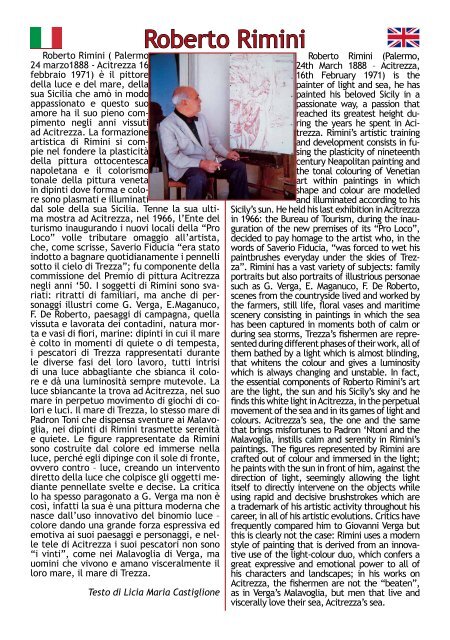Guida turistica Aci Trezza 2013 - Xiphonia Coop. a rl - Turismo ad ...
Guida turistica Aci Trezza 2013 - Xiphonia Coop. a rl - Turismo ad ...
Guida turistica Aci Trezza 2013 - Xiphonia Coop. a rl - Turismo ad ...
Create successful ePaper yourself
Turn your PDF publications into a flip-book with our unique Google optimized e-Paper software.
Roberto Rimini ( Palermo<br />
24 marzo1888 - <strong>Aci</strong>trezza 16<br />
febbraio 1971) è il pittore<br />
della luce e del mare, della<br />
sua Sicilia che amò in modo<br />
appassionato e questo suo<br />
amore ha il suo pieno compimento<br />
negli anni vissuti<br />
<strong>ad</strong> <strong>Aci</strong>trezza. La formazione<br />
artistica di Rimini si compie<br />
nel fondere la plasticità<br />
della pittura ottocentesca<br />
napoletana e il colorismo<br />
tonale della pittura veneta<br />
in dipinti dove forma e colore<br />
sono plasmati e illuminati<br />
dal sole della sua Sicilia. Tenne la sua ultima<br />
mostra <strong>ad</strong> <strong>Aci</strong>trezza, nel 1966, l’Ente del<br />
turismo inaugurando i nuovi locali della “Pro<br />
Loco” volle tributare omaggio all’artista,<br />
che, come scrisse, Saverio Fiducia “era stato<br />
indotto a bagnare quotidianamente i pennelli<br />
sotto il cielo di <strong>Trezza</strong>”; fu componente della<br />
commissione del Premio di pittura <strong>Aci</strong>trezza<br />
negli anni ‘50. I soggetti di Rimini sono svariati:<br />
ritratti di familiari, ma anche di personaggi<br />
illustri come G. Verga, E.Maganuco,<br />
F. De Roberto, paesaggi di campagna, quella<br />
vissuta e lavorata dei cont<strong>ad</strong>ini, natura morta<br />
e vasi di fiori, marine: dipinti in cui il mare<br />
è colto in momenti di quiete o di tempesta,<br />
i pescatori di <strong>Trezza</strong> rappresentati durante<br />
le diverse fasi del loro lavoro, tutti intrisi<br />
di una luce abbagliante che sbianca il colore<br />
e dà una luminosità sempre mutevole. La<br />
luce sbiancante la trova <strong>ad</strong> <strong>Aci</strong>trezza, nel suo<br />
mare in perpetuo movimento di giochi di colori<br />
e luci. Il mare di <strong>Trezza</strong>, lo stesso mare di<br />
P<strong>ad</strong>ron Toni che dispensa sventure ai Malavoglia,<br />
nei dipinti di Rimini trasmette serenità<br />
e quiete. Le figure rappresentate da Rimini<br />
sono costruite dal colore ed immerse nella<br />
luce, perché egli dipinge con il sole di fronte,<br />
ovvero contro – luce, creando un intervento<br />
diretto della luce che colpisce gli oggetti mediante<br />
pennellate svelte e decise. La critica<br />
lo ha spesso paragonato a G. Verga ma non è<br />
così, infatti la sua è una pittura moderna che<br />
nasce dall’uso innovativo del binomio luce –<br />
colore dando una grande forza espressiva ed<br />
emotiva ai suoi paesaggi e personaggi, e nelle<br />
tele di <strong>Aci</strong>trezza i suoi pescatori non sono<br />
“i vinti”, come nei Malavoglia di Verga, ma<br />
uomini che vivono e amano visceralmente il<br />
loro mare, il mare di <strong>Trezza</strong>.<br />
Roberto Rimini Roberto Rimini (Palermo,<br />
Testo di Licia Maria Castiglione<br />
24th March 1888 – <strong>Aci</strong>trezza,<br />
16th February 1971) is the<br />
painter of light and sea, he has<br />
painted his beloved Sicily in a<br />
passionate way, a passion that<br />
reached its greatest height during<br />
the years he spent in <strong>Aci</strong>trezza.<br />
Rimini’s artistic training<br />
and development consists in fusing<br />
the plasticity of nineteenth<br />
century Neapolitan painting and<br />
the tonal colouring of Venetian<br />
art within paintings in which<br />
shape and colour are modelled<br />
and illuminated according to his<br />
Sicily’s sun. He held his last exhibition in <strong>Aci</strong>trezza<br />
in 1966: the Bureau of Tourism, during the inauguration<br />
of the new premises of its “Pro Loco”,<br />
decided to pay homage to the artist who, in the<br />
words of Saverio Fiducia, “was forced to wet his<br />
paintbrushes everyday under the skies of <strong>Trezza</strong>”.<br />
Rimini has a vast variety of subjects: family<br />
portraits but also portraits of illustrious personae<br />
such as G. Verga, E. Maganuco, F. De Roberto,<br />
scenes from the countryside lived and worked by<br />
the farmers, still life, floral vases and maritime<br />
scenery consisting in paintings in which the sea<br />
has been captured in moments both of calm or<br />
during sea storms, <strong>Trezza</strong>’s fishermen are represented<br />
during different phases of their work, all of<br />
them bathed by a light which is almost blinding,<br />
that whitens the colour and gives a luminosity<br />
which is always changing and unstable. In fact,<br />
the essential components of Roberto Rimini’s art<br />
are the light, the sun and his Sicily’s sky and he<br />
finds this white light in <strong>Aci</strong>trezza, in the perpetual<br />
movement of the sea and in its games of light and<br />
colours. <strong>Aci</strong>trezza’s sea, the one and the same<br />
that brings misfortunes to P<strong>ad</strong>ron ‘Ntoni and the<br />
Malavoglia, instills calm and serenity in Rimini’s<br />
paintings. The figures represented by Rimini are<br />
crafted out of colour and immersed in the light;<br />
he paints with the sun in front of him, against the<br />
direction of light, seemingly allowing the light<br />
itself to directly intervene on the objects while<br />
using rapid and decisive brushstrokes which are<br />
a tr<strong>ad</strong>emark of his artistic activity throughout his<br />
career, in all of his artistic evolutions. Critics have<br />
frequently compared him to Giovanni Verga but<br />
this is clea<strong>rl</strong>y not the case: Rimini uses a modern<br />
style of painting that is derived from an innovative<br />
use of the light-colour duo, which confers a<br />
great expressive and emotional power to all of<br />
his characters and landscapes; in his works on<br />
<strong>Aci</strong>trezza, the fishermen are not the “beaten”,<br />
as in Verga’s Malavoglia, but men that live and<br />
viscerally love their sea, <strong>Aci</strong>trezza’s sea.


